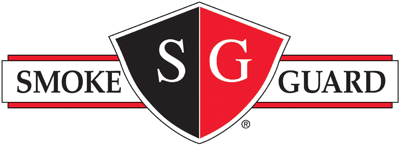Design Alternatives to the Enclosed Elevator Lobby: Fire and Smoke Safety Solutions
![]() Continuing Education
Continuing Education
Use the following learning objectives to focus your study while reading this month’s Continuing Education article.
Learning Objectives - After reading this article, you will be able to:
- Explain the building code requirements for fire and smoke containment at the elevator shaft.
- Describe the enclosed elevator lobby solution mandated by the IBC.
- Compare and contrast available alternatives to the traditional enclosed elevator lobby solution.
- Describe unique fire and smoke code requirements and solutions for areas of refuge, countertop enclosures, healthcare facilities, and prisons.
Smoke and Fire in the Built Environment
The National Fire Protection Association (NFPA) reported that in 2010, in the United States, there were fires in 90,500 apartment buildings, 12,000 public assembly properties, 5,500 educational properties, 5,500 institutional properties, and 18,000 stores and offices. 555 civilians died in these fires and over 6,000 were injured. Property losses in these fires exceeded $2.2 billion. While these tragedies occurred during a fire, the real culprit was the smoke. According to FEMA, asphyxiation is the leading cause of fire deaths, exceeding burns by a three-to-one ratio.
Both evidence and experience confirm that buildings must be designed to protect occupants from fire and smoke, but debate continues to rage about the best way to provide that protection. Active fire suppression systems, such as automatic sprinklers, have proven to be very effective at containing the spread of fire throughout a building, but do little to combat the creation and spread of dangerous smoke. Passive fire protection systems manage fire spread by dividing a building into distinct fire containment compartments equipped with fire-rated floors, walls, doors, door hardware, and duct penetrations. These passive systems act to restrict the movement of smoke. Walls serve as smoke barriers keeping the smoke from migrating into other parts of the building, but smoke easily maneuvers around ungasketed fire-rated doors and into open space.
The International Building Code (IBC) is the most widely adopted building code in the United States, providing a single set of comprehensive and coordinated construction and design codes that guide the development of projects nationwide. "In terms of fire and life safety, the general goal of the IBC is to ensure that if a fire occurs in a building, it won't grow too rapidly and occupants will have the ability to escape," explained fire code consultant Gregory J. Cahanin, Cahanin Fire and Code Consulting. "In a multi-story building, the IBC mandates that automatic sprinklers be installed to contain the spread of fire and works to compartmentalize every floor, so that if a fire occurs, it stays on the floor where it began."
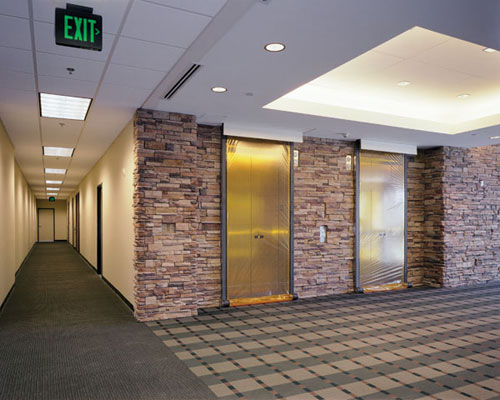 |
|
Shown here: rolling magnetic gasketing system. Photo © Brett Drury Architectural Photography, Inc. |
Despite the combination of active and passive fire containment techniques written into the building code, smoke migration has continued to be a dangerous and deadly aspect of building fires. Over the past decade, the IBC has recognized the need to better contain the spread of smoke in a multi-story building and has begun requiring that buildings also be equipped with smoke protection for horizontal assemblies, in addition to the active and passive fire containment systems already described.
Today, the IBC mandates smoke protection in several different areas throughout a multi-story building. Smoke protection is required at the elevator shaft, in areas of refuge, to separate an atrium from the rest of the building, and wherever a fire and smoke rated wall has been opened up to provide access or counter space. Additionally, smoke protection needs to be added to most multi-story historical renovations to bring the existing building into compliance with current fire and life safety codes which require both vertical and horizontal barriers that may not have been in place originally.
Smoke and Fire in the Elevator Shaft
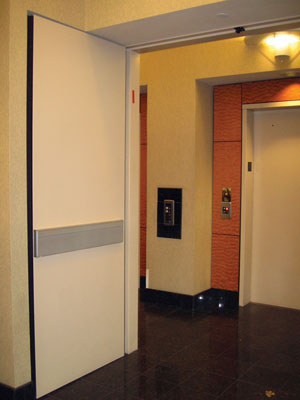 |
Section 707.14.1 of the 2006 IBC prescribes that design teams incorporate a fire-rated, enclosed elevator lobby at the elevator shaft. The code also identifies seven exceptions to this rule. Photo courtesy of Smoke Guard, Inc. |
Elevator shafts act like chimneys in multi-story buildings enabling large quantities of air to move from floor to floor and, when a fire occurs, acting as a conduit transporting smoke throughout a building. The heated smoke enters the elevator shaft from the fire floor and rises, displacing the resident cooler, denser air. Stack effect pressures in the elevator hoistway draw this cool smoke up through the vertical shaft. As the smoke rises, it easily leaks back through the elevator doors and onto other floors, spreading quickly beyond its point of origination and exposing occupants on upper floors to this dangerous and toxic hazard. Despite design teams' best efforts to compartmentalize, the vertical elevator shaft compromises each floor and must be specifically addressed to provide fire, smoke, and life safety in the built environment.
IBC Requires an Enclosed Elevator Lobby -
or Something Better
Where three or more stories are connected by an elevator shaft, architects are required, by the IBC, to isolate each floor from the elevator shaft with both fire and smoke protection. In IBC 2009 Section 708.14.1 (IBC 2012 713.14.1), the IBC prescribes in its charging language that design teams incorporate a fire-rated, enclosed elevator lobby onto each floor to provide the requisite separation. As the name may suggest, an enclosed elevator lobby is a room that is built around the elevator doors that can be closed off from the rest of the floor in the event of a fire. The code mandates, in Section 708, that the fire partitions shall have a fire rating of not less than one hour and, in accordance with Section 715, that the openings in fire partitions must be protected by an opening protective with a minimum of a 20 minute fire rating. Simply put: the enclosed elevator lobby must be constructed with walls that have a one hour fire rating and doors that have a 20 minute fire rating, as a minimum.
Beyond the requisite fire rating, it is also mandated in the IBC that the corridor walls and doors in them shall resist the passage of smoke. The code contains the construction requirements for creating wall assemblies that are capable of restricting the movement of smoke from one side of the wall to the other. The doors or opening protectives must meet the air leakage performance outlined by the Underwriters Laboratories (UL) 1784 test. These air leakage tests of door assemblies examine the rate that air and smoke leak from one side of the door to the other and establish that particular door assemblies appropriately resist the spread of smoke.
In order to meet the fire and smoke protection requirements, architects commonly specify fire-rated swing doors with gaskets as the doors used to enclose a lobby. When the swing doors close, the gasket fills in the empty space between the door and the frame, creating a seal to prevent smoke from leaking out of the vestibule. This lobby becomes a barrier on the fire floor keeping smoke from penetrating the elevator shaft and, simultaneously, prevents smoke from migrating out of the elevator shaft onto a non-fire floor.
While enclosed elevator lobbies are the code-prescribed solution for maintaining fire, smoke, and life safety at the elevator shaft, they are often far from ideal in terms of how they can impact an architect's designs. In some buildings, like a standard office tower, elevator lobbies are naturally created amidst a bank of elevators, which makes the vestibule easy to incorporate into the space. However, in building types that are more complex, or that have design intentions that significantly differ from the standard office tower, the vestibule solution can create a real challenge for an architect trying to figure out how to incorporate enclosed lobbies into the design. Additionally, it can be a challenge to create a vestibule that feels open and continuous with the rest of the building.
Another problem that is commonly cited with the lobby fire and smoke barrier solution is the amount of floor space that it requires to execute. Instead of setting aside dead space on every floor for an enclosed elevator lobby, architects could use that space to add one more hotel room or hospital room to the floorplan, or create larger condos generating more revenue for the owner from essentially the same footprint.
Over the years, new products, systems, and design techniques have been developed giving architects more tools to create fire and smoke barriers than the basic construction materials used to build self-contained boxes around the elevator doors. There are now code-compliant alternatives to the enclosed elevator lobby enabling architects to meet fire and life safety code requirements with a much smaller intrusion on the building's floorplate. In response to the dynamic construction environment and new practices and tools available, the codes have evolved to identify instances when an enclosed elevator lobby is no longer necessary and to allow architects to implement fire and smoke containment solutions that are equal to or superior to the enclosed elevator lobby of long ago. IBC 2009 specifically identifies seven exceptions to the enclosed elevator lobby mandated by Section 708.14.1 (IBC 2012 713.14.1) and an allowance for alternative means and modes.
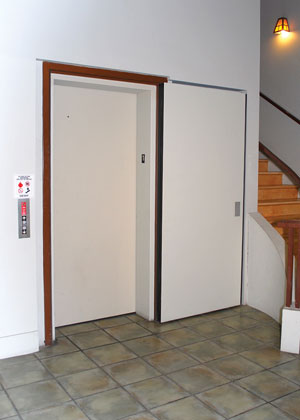 |
A swing door mounted at an elevator opening and held open with a magnetic hold meets the fire and smoke partition code requirements, but can be susceptible to tenant tampering and have an undesirable aesthetic effect in the space. Photo courtesy of Smoke Guard, Inc. |
Exception 1: Ground Floor of a Building with Automatic Sprinklers
Exception one applies to buildings where the ground floor is equipped throughout with automatic sprinklers. When the ground floor is protected with automatic sprinklers, enclosed elevator lobbies on the ground floor are not necessary to meet fire and life safety codes. Most new buildings will incorporate automatic sprinklers throughout the building and will qualify for this ground floor exception.
Exception 2: No Elevator Shaft
In buildings where the elevator is not enclosed in an elevator shaft, there is no requirement for an enclosed elevator lobby to separate the shaft from the rest of the floor. Elevators entirely within a hotel atrium are a common application of this provision.
Exception 3: The Additional Door Option
Another way to avoid designing an enclosed elevator lobby onto each floor is to specify that a gasketed swing door be mounted directly at the elevator opening and held open with a magnetic hold device. The IBC refers to this door as an "additional door" and as long as it carries an S rating (smoke rating), is equipped with a closer, the device that pulls the door closed when the magnetic hold-open releases, is "openable from the elevator car side without the use of a key, tool, knowledge, or special effort", and is tested in accordance with UL 1784 for air leakage, this swing door solution readily meets the fire and smoke barrier code requirements for the space. In the event of a fire, the magnetic hold-open releases and the swing doors close over the elevator opening. The gasketing along the jamb of the door assembly fills in the space between the swing door and the door frame, creating a seal to block smoke from trespassing onto the floor. A drop seal is mounted to the door undercut to prevent smoke migration at the sill.
While this solution is much more space friendly than creating an enclosed elevator lobby on each floor, there are a few concerns that should be considered before mounting swing doors to the elevators in your designs. Swing doors closed over the elevator door can impede firefighter access to the area and creates a visible barrier between a firefighter riding the elevator and an occupant waiting on the floor. Additionally, swing doors are often wedged open by tenants or inadvertently blocked by furnishings on the floor. If they are unable to properly close, they are useless as a smoke barrier.
Exception 4: Sprinkler Trade-Off
Buildings less than 75 feet in height that have sprinklers installed throughout, do not need to isolate the elevator shaft from the rest of the building. Healthcare facilities (I-2) have other special requirements defined in Section 407 regarding protection from smoke migration. I-3 occupancies (confinement facilities and prisons) and buildings more than 75 feet in height cannot apply this exception.
Exception 5: Sprinklers and Smoke Partitions
Where a building is equipped with an automatic sprinkler system, the fire and smoke partition required at the elevator shaft can be reduced to smoke partition construction, which means that the assembly can be rated for smoke protection only and no longer needs a fire rating. Additionally, the opening protective, or door, in a smoke partition needs only to be rated in accordance with UL 1784. Since the building code requires that all high rise buildings have automatic sprinkler systems, many high rises can take advantage of this exception.
Exception 6: Elevator Shaft Pressurization
The IBC recognizes that elevator shaft pressurization can be used to separate the elevator shaft from the rest of the building in lieu of enclosed elevator lobbies. Elevator shaft pressurization contains smoke migration by using fans to inject large quantities of air into the elevator shaft in order to create a positive pressure environment in which smoke can not enter the hoistway or move freely from floor to floor. Section 707.14.2 describes all requirements that must be met by the elevator shaft pressurization system.
Successfully maintaining a positive pressure environment can be a very effective solution for smoke containment-even keeping smoke confined in the office suite or condo where the fire originated and out of egress pathways. Unfortunately, there are many obstacles to maintaining a positive pressure environment in an elevator shaft. Shaft pressurization systems are complex electrical and mechanical systems. Floor loading designs must consider their impact as well. One challenge is the fact that the elevator doors leak considerable amounts of air from the shaft onto each floor, causing the shaft to lose pressure continually. Designs must consider fans large enough to overcome leakage and emergency generators to power them.
It is important to evaluate the plausibility of a pressurized system on a project by project basis. Enclosed elevator lobbies and swing doors mounted in front of elevator doors can be used for fire and smoke protection in buildings of any height. While pressurization is not limited by building height, engineering considerations indicate that effective elevator shaft pressurization can only occur in low/mid-rise and some high rise buildings. The size of the shaft and the number of cars in the shaft are among the factors that will determine how many floors can be effectively and economically pressurized.
Alternative Means and Modes
As previously mentioned, the code doesn't explicitly describe every alternate solution available to architects for replacing the enclosed elevator lobby on a project. Section 104.11 allows for alternative means and methods of construction that are equal to or superior to the requirements in the code. The International Code Council (ICC) evaluates various products and design solutions and tests them against the initial enclosed elevator lobby standards. This agency approves or denies the application of that solution as a substitute for an enclosed elevator lobby in its published Evaluation Service Report (ESR). Two products that have been approved by the ICC as viable substitutes to an enclosed elevator lobby are horizontal sliding accordion doors and rolling magnetic gasketing systems.
Accordion Doors
Accordion doors are large, steel doors that hide in a pocket in the wall and deploy horizontally along a track in the ceiling when a fire is detected. These products can bend around corners, unusual shapes, escalators, and other building fixtures, providing a highly flexible fire and smoke barrier solution. The doors can be fire-rated and use gaskets to create a seal with the walls, ceiling and floor once fully deployed to provide the requisite smoke resistance. These products slide into place to create an enclosed elevator lobby if a fire occurs, but are housed out-of-sight, allowing architects to leave the space open during regular day-to-day activities. Even though these accordion doors are often hidden, they still require that architects architects earmark a certain amount of space for the enclosed elevator lobby that will be created when the doors deploy.
Rolling Magnetic Gasketing System
A rolling magnetic gasketing system creates a smoke barrier at the elevator shaft opening by deploying a reinforced, transparent, polymide film down over the shaft door when smoke is detected in the area. The edges of the film are equipped with flexible magnetic strips that adhere to metal rails on either side of the doorway providing a virtually air-tight seal. The ICC recognizes the combination of the normally fire-rated elevator hoistway doors and the rolling magnetic gasketing system, which deploys an air-tight film over the shaft door, as an approved alternative for an enclosed elevator lobby. The fire-rated elevator doors provide the requisite fire protection and the UL 1784-tested rolling magnetic gasketing system provides the necessary smoke protection.
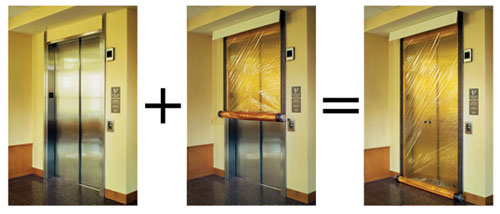 |
The combination of the fire-rated elevator doors and the UL 1784-tested rolling magnetic gasketing system meets the IBC code requirement that prescribes an enclosed elevator lobby at the elevator shaft. Photo courtesy of Smoke Guard, Inc. |
Â
This solution eliminates the need to incorporate an enclosed elevator lobby in the architectural design, returning an incredible amount of space to the floorplate. "These rolling magnetic gasketing systems essentially create a smoke containment vestibule right in front of each elevator door opening that is three inches deep, rather than a couple hundred square feet. They are less obtrusive to circulation flows in a building and aesthetically occupants don't feel like they are getting off of the elevator into a little alcove or box. In fact, they won't even notice it," states Mike DeOrsey, Project Manager, Burt Hill, Boston, MA.
Many design professionals believe that specifying accordion doors and rolling magnetic gasketing systems in front of the elevator opening meets the additional door criteria (Exception 3) more effectively and aesthetically than swing doors.
Performance Comparison
Available alternatives to the traditional enclosed elevator lobby include: swing doors, accordion doors, elevator pressurization systems and rolling magnetic gasketing systems. While each of these appropriately provides the fire and smoke barriers required by the IBC, they are very different solutions in terms of the air leakage performance, life cycle maintenance, and overall costs associated with each.
Air Leakage Performance
Air leakage describes the amount of air and smoke that passes from one side of the smoke barrier to the other. Lower air leakage rates indicate better, more air-tight smoke and draft control assemblies, because less smoke and air is able to breach the barrier and migrate further into the building or elevator shaft. The UL 1784 air leakage standard tests the maximum allowable air leakage rate at three cubic feet per minute (cfm) per square foot of door opening, measured at defined pressures and temperatures. To meet this air leakage test, the doors or opening protectives that serve as smoke and draft control assemblies must be designed to fit snugly in the space. As a point of reference, standard fire-rated elevator doors are allowed a 3/8 inch gap between the door and the frame by NFPA 252 standard. This fractional gap can allow up to 900 cubic feet of smoke per minute to pass through the elevator opening, when the doors are in the closed position. Fire-rated elevator doors are a great example of an approved fire rated opening protective that is not an acceptable smoke and draft control assembly.
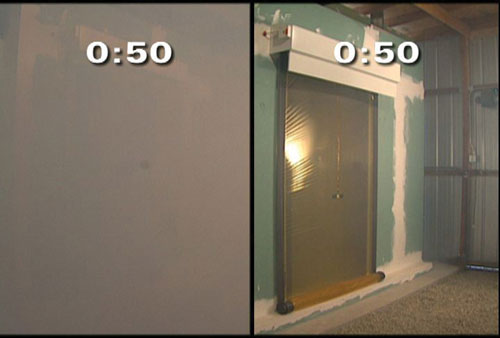 |
The combination of the fire-rated elevator doors and the UL 1784-tested rolling magnetic gasketing system meets the IBC code requirement that prescribes an enclosed elevator lobby at the elevator shaft. Photo courtesy of Smoke Guard, Inc. |
Any smoke and draft control assembly must be less than the UL 1784 air leakage performance standard of three cfm/sq. ft before it can be specified onto a project. The UL 1784 test typically allows for the undercut of a swing door to be taped closed. However, under exception 3, the code specifically requires that the undercut on swing doors used as an additional door not be taped during this test. The pressure differential that can exist at the shaft paired with the space between the undercut of the door and the floor can allow smoke to migrate from one side of the barrier to the other at a much faster rate than 3 cfm/sq. ft. Avoid specifying a product that may leak excessively at the elevator shaft by either verifying that the door has a drop seal in place or has been tested in an elevator shaft scenario or without the undercut taped.
An accordion door is another type of smoke barrier that may perform differently in a pressurized environment than the UL 1784 test environment. Accordion doors use a rubber skirt to create a smoke resistant seal between the large steel accordion door and the floor. In a large pressurized space where a smoke control system may be used, the air pressure can exert a considerable force upon the broad curtain surface pushing or pulling the door out of place or causing it to swing. Either way, the seal at the bottom of the door can lift away from the floor enabling significant amounts of smoke to breach the barrier.
Rolling magnetic gasketing systems achieve an UL 1784-tested air leakage rate ranging between 0.33 and 0.6 cfm/sf of door opening. These air leakage rates are so low that the UL 1784 testing procedures had to be modified to be able to accurately measure the air leakage of this system. Additionally, these products are designed to operate at the elevator shaft and the performance of these systems is unaffected by pressurized environments. Tom Allen, the inventor of rolling magnetic gasketing systems and founder of Smoke Guard, was a practicing commercial architect who wanted to provide a better barrier against smoke migration than what was currently available on the market. "If there is hazardous air on one side of a barrier that you don't want on the other side and you don't want a wall there all of the time, nothing prevents smoke migration better than a rolling magnetic gasketing system," explained Mr. Allen.
While elevator pressurization systems are designed to prevent the migration of smoke in a building, they are not smoke barriers that can be UL 1784 tested. The air leakage performance of these systems varies on a project by project basis and is, in large part, dependent upon the engineering team designing it. The acceptance testing of pressurization systems conducted by code officials vary greatly.
Life Cycle Maintenance
The life cycle maintenance cost of a fire and smoke barrier system identifies the effort and expense necessary to keep the system functional over the life of the building. It is generally accepted that the more complex and costly a system is to maintain, the less likely it is that owners or facility maintenance personnel will follow the prescriptive requirements.
Swing doors, whether enclosing an elevator lobby or mounted at the elevator door on a magnetic hold open, are highly susceptible to tenant tampering. Many swing doors will swing shut in response to a general alarm regardless of if the alarm is false or real or as a result of a power loss. When deployed incorrectly, these doors interfere with regular building traffic and will often be wedged open by building occupants or tenants. Facility maintenance teams must constantly watch for and remove swing door obstructions to ensure that when there is an emergency the doors are able to function as expected. Beyond vigilantly monitoring for tampering, the closers on swing doors, the apparatus that forces the door to close and latch under its own pressure, must be adjusted periodically to guarantee that the door will work correctly when needed. If the door doesn't latch, it will not function as a fire or smoke barrier.
Rolling magnetic gasketing systems are maintained by facility managers or maintenance staff. Every six months the system should be deployed and rewound to ensure functionality. It does not require oversight from an engineer or licensed third party inspector and the units themselves are hidden in a housing above the elevator door, removing them from view and making it less likely that they will be subject to tampering.
Elevator shaft pressurization systems must be maintained by third party experts with knowledge in mechanical engineering, fire protection engineering, and air balancing. While these complex systems are fairly tenant tamper-proof, the time and expense incurred to maintain the system can be prohibitive.
| Flagler Station Marriott Courtyard |
Architect Bernardo Sandoval, Associate Project Manager for Beame Architectural Partnership, was able to meet fire and life safety codes requiring enclosed elevator lobbies and maximize the usable space on each floor by incorporating a rolling magnetic gasketing system at the elevator doors. The five-story Marriott Courtyard project constructed in Miami, Florida was required, by the Florida 2004 building code, section 707.14.1, to provide an enclosed elevator lobby on floors two through five. Instead of building the code-prescribed vestibule into his design, Mr. Sandoval specified the rolling magnetic gasketing system at the elevator hoistway and was able to add an additional sleeping room on every floor, increase the size of every unit by six to eight inches, and provide more space in the back of the house. "Using the rolling magnetic gasketing system, instead of an enclosed elevator lobby, I was able to dramatically reduce the size of the corridor and redistribute the saved space in ways that made the building more valuable," explained Mr. Sandoval. "The four extra hotel rooms I was able to add will generate additional revenue for the hotel owner throughout the life of the building and the product that made it possible had a payback period of less than six months." |
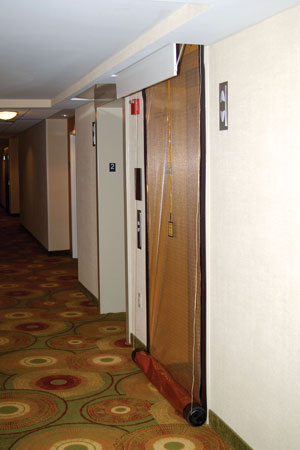 |
"Using the rolling magnetic gasketing system, instead of an enclosed elevator lobby, I was able to dramatically reduce the size of the corridor and redistribute the saved space in ways that made the building more valuable," explained Associate Project Manager Bernardo Sandoval. Photo courtesy of Smoke Guard, Inc. |
Cost Comparisons
The total cost of these different fire and smoke safety solutions for vertical shafts is a combination of the price of the materials and labor required for installation and the amount of valuable square footage required to add these barriers to the floorplan. The framing and drywall materials required to build an enclosed elevator lobby on each floor may have a minimal price tag, but the significant amount of space required by this solution quickly escalates the cost. Elevator shaft pressurization systems are building-wide systems comprised of fans, ducting, and other equipment that are designed on a caseby- case basis by specialized engineering teams. Just as the design of these systems can differ substantially from one project to the next, so can the cost, which is often significant. Although accordion doors are often hidden from view, the physical weight and materials necessary to incorporate accordion doors onto a project will not go unnoticed. The large, steel curtains weigh a significant amount and considerable construction can be involved to build the deep pocket and create the overhead track. Additionally, if the ceiling is not stable enough, anchors will need to be added to provide the necessary support. A rolling magnetic gasketing system uses fewer and lighter materials than any of the other potential smoke protection devices. This system of high-tech film and magnets adds roughly 60 pounds at each elevator door. The code has always required that the elevator shaft doors be fire-rated to compartmentalize each floor and restrict the movement of fire, so the only additional equipment required to complete the requisite fire and smoke barrier on each floor is the rolling magnetic gasketing system, which mounts above individual elevator doors and requires no valuable floor space.
Areas of Refuge
Since the early 1990s, building codes have required that design teams create spaces in multi-story buildings, usually one per floor, for individuals with mobility impairments to be able to safely wait out the effects of fire. These areas of refuge protect occupants from both fire and smoke. They must be both a fire-rated enclosure and a smoke-rated enclosure to protect occupants unable to move away from the fire event. There are two solutions for architects creating areas of refuge. They can create an area of refuge out of a traditional enclosed elevator lobby that is fire and smoke-rated. Another solution is to use a fire-rated and smoke-rated rolling magnetic gasketing system to enclose and protect the area of refuge.
Fire-Rated/Smoke-Rated Rolling Magnetic Gasketing System
A fire-and-smoke-rated rolling magnetic gasketing system provides a smoke and fire-rated barrier to keep hazardous heat and smoke out of these predetermined safety areas. When smoke is detected at an opening or entrance to the area of refuge, these systems deploy a fire-rated fabric curtain edged with flexible magnets. These magnets attach to auxiliary rails on either side of the opening and create a virtually air-tight seal protecting building occupants from the smoke, toxins, and heat on the other side. Building occupants can easily enter or exit through the deployed screen by either using a screen rewind switch mounted on the screen or by applying less than fifteen pounds of pressure on either side to separate the screen from the auxiliary rails.
Countertops in Fire or Smoke Rated Walls
There are many instances, in different types of buildings, where a fire-rated or smoke-rated wall has been structurally modified to provide a counter space between two different areas. Examples include pharmacy dispensary areas in hospitals, business reception areas, higher education administration areas, and expediting areas linking kitchens and dining rooms. The creation of a counter space means that the wall now only partially separates the two areas, instead of providing complete fire or smoke separation as required. In order to have a countertop opening in a fire-rated or smoke-rated wall, the IBC requires the rating of the wall be maintained by specifying an appropriate fire or smoke-rated assembly in the opening that can be closed in case an emergency occurs. Rolling steel doors and smoke curtain systems are two popular assemblies used to maintain the integrity of the barrier.
Rolling Steel Doors
Steel roll-down doors are the traditional solution chosen by architects to complete the fire-and-smoke-rated walls in countertop situations. In some instances, the countertop pass through must be able to be closed and locked. Steel roll-down doors provide a doubleduty solution, because they are able to meet both the life safety and security barrier requirements.
 |
A fire-and-smoke-rated rolling magnetic gasketing system provides the required smoke and fire-rated barrier necessary to protect an area of refuge. Photo courtesy of Smoke Guard, Inc. |
Â
Smoke Curtain Systems
A new solution for a code-mandated countertop assembly is a smoke curtain system. Smoke curtain systems use a smoke-rated fabric and side guides to create a high-performance smoke barrier that will resist air leakage. The curtains are mounted above the ceiling and deploy when local smoke detectors sense smoke.
Solution Comparisons
Steel doors are typically bulky and heavy. Smoke curtains are significantly lighter solutions, adding between 60 and 150 pounds at each countertop application. While both solutions are excellent smoke and fire barriers, rolling steel doors can represent a different type of health hazard to human occupants, because the heavy doors can deploy inadvertently. Staff members behind the counter often block the rolling steel door open to protect themselves and patients or customers. Additionally, when the doors do deploy, they often require that a company technician visit the building and reset the door to ensure that the trigger mechanism is properly in place again. Smoke curtain systems can be easily rewound by a facility manager and do not require any third party expertise for maintenance.
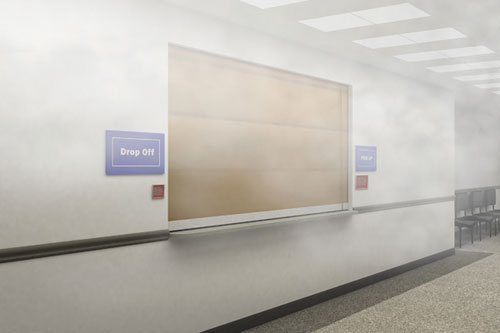 |
Smoke curtain systems provide an alternative solution to the rolling steel doors often specified to complete countertop enclosures in fire or smoke-rated walls. Photo courtesy of Smoke Guard, Inc. |
Â
Atriums
While atriums are often designed into multi-story buildings to open up the space and provide building occupants with more access to natural light, these central spaces have been recognized as a weak point in building fire safety, because they allow fire and smoke to spread to the upper stories of a building more quickly.
Depending upon the size of the atrium, stack effect can occur, naturally drawing smoke into the atrium and up through the building. In an outdoor environment, this would provide a natural mode of egress for the smoke, but in a building the smoke and soot will collect at the ceiling or roof and fall back down into the interior, occupied spaces. Building occupants on every level of the atrium need to be protected from fire and smoke, so that they can safely move away from the atrium to the emergency exits in the building.
In order to provide this protection, the IBC mandates the inclusion of two safety systems in an atrium: a smoke control system to help ventilate the area and a one hour rated fire barrier on every floor to separate the atrium from the rest of the building. The smoke control system can be either active, using fans, or passive, employing louvers or vents, to manage the smoke in the space. Use of a smoke control system also allows the designer to leave as many as three floors open to the atrium space as long as the design of the smoke control system takes this added space into account. The fire barriers and opening protectives on each floor also help to contain the smoke in the area of origination, whether that is on a floor or in the atrium, and minimize the areas of the building that will incur smoke damage. The barriers also eliminate smoke migration and protect people on non-fire floors from hazardous smoke exposure.
Healthcare Facilities and Prisons
IBC code specifies that buildings equipped with automatic sprinklers are exempt from the enclosed elevator lobby requirement, with the exception of high-rise buildings, healthcare facilities, and prisons or confinement facilities. Healthcare facilities and prisons are also required to incorporate two or more smoke compartments on each floor. These extra code requirements are in place because the institutional tenants found in healthcare facilities and prisons are not free to evacuate. Staff in these institutions must execute a defend-in-place strategy when a fire occurs using sprinklers, fire extinguishers, and smoke compartments. A smoke compartment is essentially a six-sided box encased by walls constructed as smoke barriers with a minimum of a one-hour fire rating and with opening protectives that are rated in accordance with UL 1784.
Thinking Outside the Box
Architects today have a variety of code-compliant solutions that will protect building occupants from fire and smoke and, simultaneously, eliminate the traditional, and space-eating, enclosed elevator lobbies from the floorplan. Each of these new solutions offers unique benefits to the building in terms of air leakage performance, maintenance costs, and overall costs to the project providing protection that is equal to or superior to the standard vestibule approach. When it comes to specifying fire and smoke safety throughout a multi-story project, healthcare facility, or prison, there are many benefits to thinking and designing outside of the box.
Â
|

